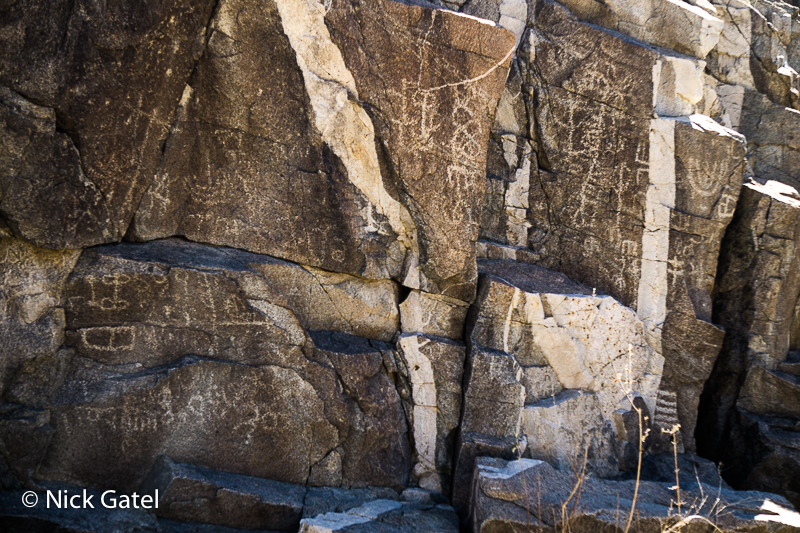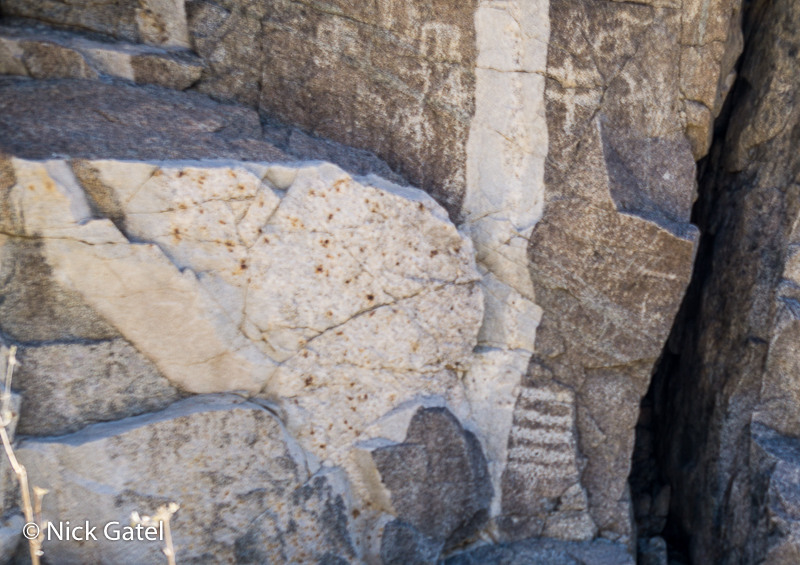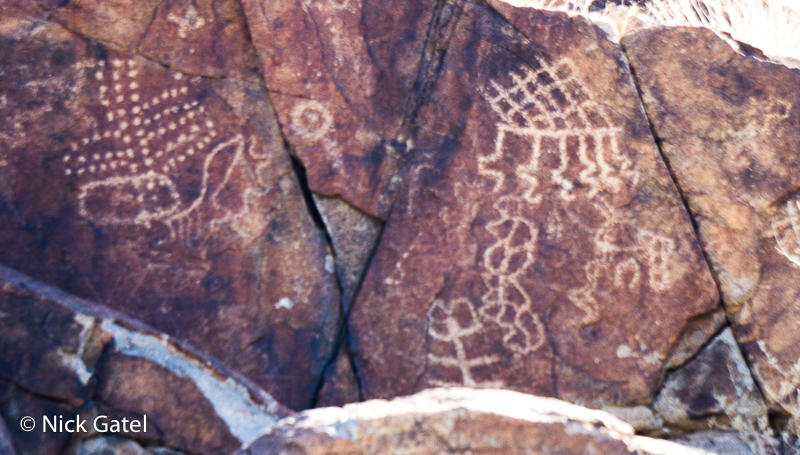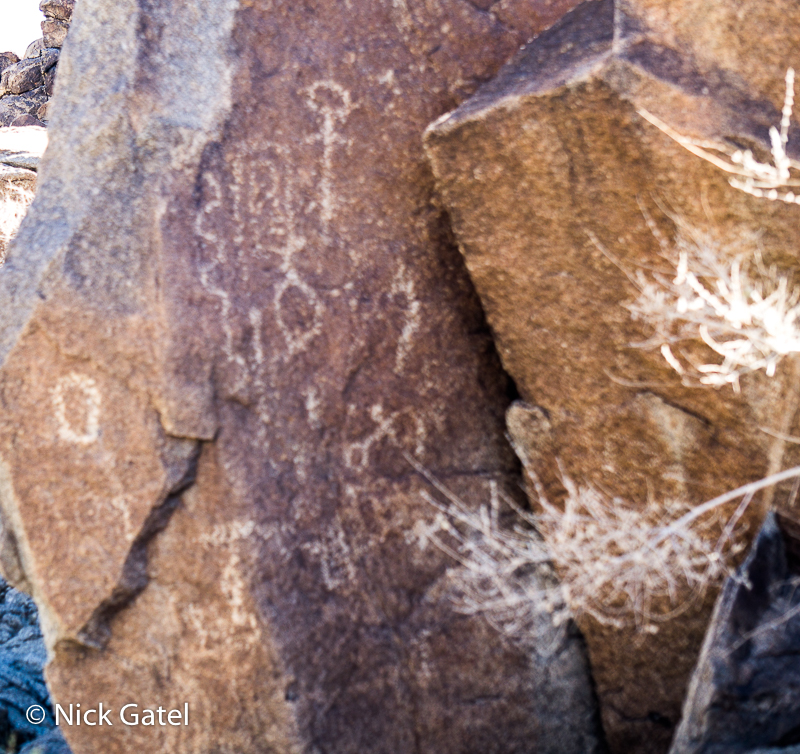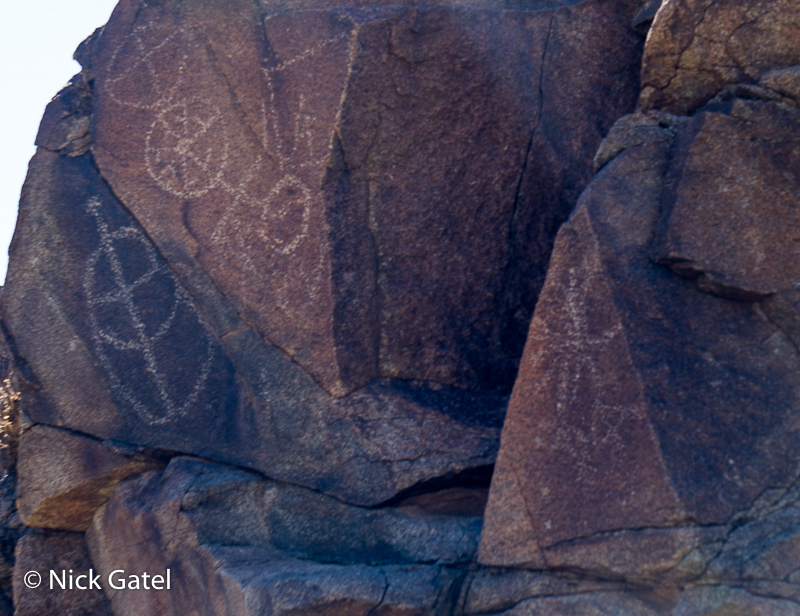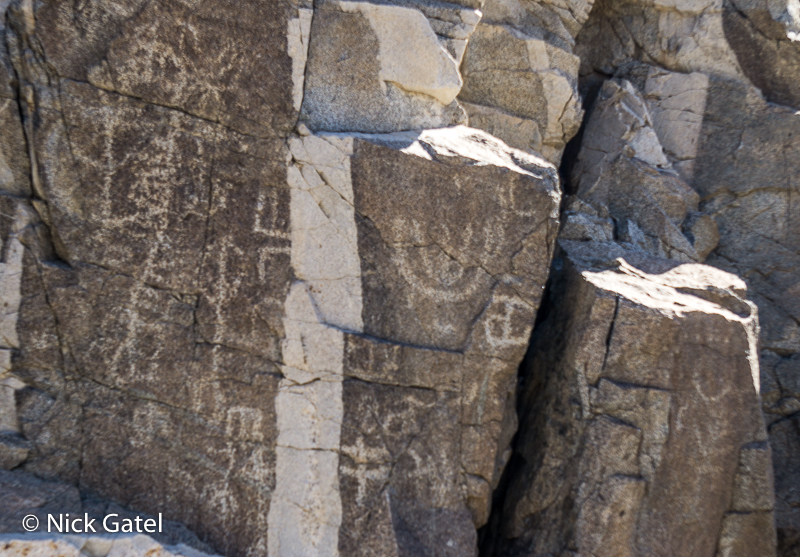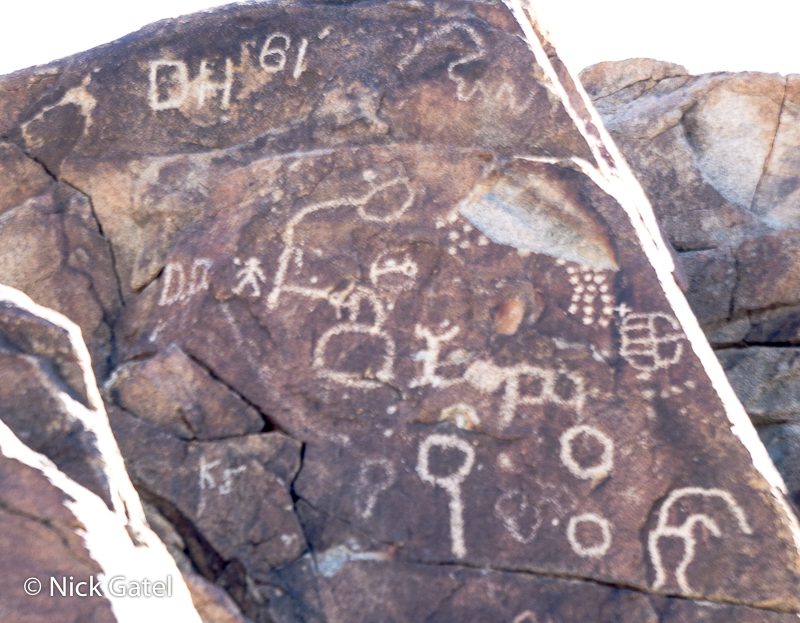Some Thoughts on Aging and Petroglyphs
Last Sunday I turned 70 years old.
My son, Joe, called the day before and suggested we go for a hike together, which was an excellent idea. No better way to celebrate any milestone of holiday than going for a walk out into the desert.
Joyce’s ankle is healing. Although she can’t walk on it, she has a scooter and a wheeled walker enabling her to get around without any assistance. So no problem for me to take off from home for a day.
Age Versus Antiquity
Since Joe was driving in from Orange County and we were hiking in my “backyard,” I decided it might be nice to pick a place with historical and cultural significance rather than an eye-candy hike. And so we headed out to a place rich in Native American petroglyphs. Joe had never been there and it would give me a chance to share a little bit about these ancient slabs of rock art. By ancient, I mean maybe older than 10,000 years. My 70 years on the planet seems insignificant compared to these petroglyphs. Not all of these pieces of rock art are that old. Some may only be a few hundred years old. We don’t know who in particular created these drawings. The artists are long gone into obscurity, but the work remains.
Art is long, and Time is fleeting,And our hearts, though stout and brave,Still, like muffled drums, are beatingFuneral marches to the grave.— Henry Wadsworth Longfellow
Is Time Fleeting?
It was just over 10 years ago that my friend Craig and I did this excellent trip and wrote about it. My 61st birthday trip seems like it happened long, long ago, but it was just 9 years ago.
The point of these two examples is, for me, time just doesn’t seem to pass by faster and faster each year as many older people might tell you. On the contrary, these trips and the dozens of trips I’ve done in the past ten years seem to be in a somewhat distant past. Distant because I have been so busy every single day doing mostly what I enjoy doing. But let’s get back to rock art.
Rock Art
Pictographs
These are images created by painting and drawing. Throughout California, Arizona, and Nevada I have seen many pictographs. More common is my experience are petroglyphs.
Petroglyphs
Over long periods of time (centuries and centuries) exposed rocks develop a patina, a kind of varnish. Where I live, we call it “desert varnish.” My chipping or chiseling with a sharp tool, the shaman could draw a picture. In modern terms it might be similar to engraving.
Is it Art?
Rock art is kind of mislabeled in my opinion. In this 2014 post, Is Photography Art? I stated
To me, art is the selective recreation of reality to communicate the artist’s life values. It reflects the artist’s philosophy. The primary arts are literature, music, and painting. Secondary arts are movies, plays, sculpture, and dance.
Ancient rock art can be found throughout the world. It seems that man needed to document important events in his life. Not as an artist nor as a historian, but more for religious reasons. So for the purpose of this post, let’s just continue to call it rock art.
Native American rock art, the experts tell us, typically recorded important events. Events experienced by the Shaman and other events that celebrated the coming of age of girls in a tribe. Most of the petroglyph sites the Southwest were places of power for shamans. In this post, Hike to a Secret Place, there are thousands of petroglyphs and I post quite a few photos in that article. Many of these petroglyphs might have been records of female coming of age ceremonies, along with the records of shamans on vision quests.
The site Joe and I visited was, more than likely, used by shamans. Not just shamans for local groups, but shamans who traveled great distances to get to this place of great power. There are places, such as the Coso Mountains near Ridgecrest, CA, where shamans would travel great distances (even from Utah and Wyoming) to conduct their vision quest.
Vision Quest
So what can we surmise about one of these shaman? Well, the place he chiseled his petroglyph became a place of power to him. He searched for a location that had a pathway to the supernatural world, and this place would have had water, or a cave (or a rock over hang), or a rock crack that provided a gateway to his journey to the other world. He was on a “vision quest” or “dreaming.”
As a shaman or a shaman apprentice he needed to enter the supernatural world to find a helper/ally to give him his shaman powers. Preparing for his vision quest he fasted, probably engaged in some sort of very tiring physical activity, maybe ingested natural tobacco (a hallucinogen), or in rare occasions might have ingested jimsonweed. All of this was done to create a hallucinogenic state. Once he was ready for his journey, he sat down and closed his eyes. The journey would entail 3 stages. The first stage was visual, but with eyes closed. Picture yourself looking at a bright light and then closing your eyes, and you will see some sort of figure on your eyelids. As he got closer to his pathway into the supernatural, his vision might have been the dots or stars we see when we close our eyes and try to look through our eye lids. And once he entered the supernatural word, he he would find his helper, perhaps a bird or other animal. He may have seen other things in the supernatural world, but the bird became his ally. After this was accomplished, he fell asleep.
As we know, often we easily forget our dreams after a short period of time. Upon awaking, we do remember it or parts of the dream. For the Shaman, he knew that if he forgot his journey into the supernatural, he would die. So he chiseled the journey on the rock. The images are not what the objects look like in real life (e.g., a bird), but what they looked like in the dream. The shaman might chisel the dots or lines he may have seen with his eyes closed, and then chisel the bird or other animal that became his ally. And this shaman would probably return to this place many times during his life, because it became his personal place of power.
Some Shamans would superimpose the images on top of each other in the order they happened. Or some would spread them out. However they created it, it was to meet their personal requirements as shamans, not to create art for others. Zig-zags often depict the sidewinder rattlesnake and diamonds a diamondback rattlesnake.
Art, Religion, or Graffiti?
As you may have gathered if you visit my blog frequently, I hike a lot in the Southern Sierra, and the southern California & Nevada deserts. I have visited over a hundred petroglyph/pictrograph sites. Some were by design, and most were somewhat accidental. Over time I have learned where this art rock might be found, and although I usually am not looking for rock art, I find it if it is there. The places I frequent most often were at one time populated by Indians that can be separated into four groups, based on the language they spoke. (1) The Great Basin Desert (Southern Nevada, Owens Valley, Death Valley & the Mohave Desert), (2) the South Central part of California (ocean to the Western Sierras), (3) the Southernmost deserts of California, and (4) the area along the lower Colorado River. The first three were very similar in religion/culture because they were hunter/gatherers. For these three, the rock art was entirely religious in nature, either made by Shamans, or participants in rites of initiation into puberty. The Colorado group tended to rely on some level of agriculture, and stayed close to the River. Their art often included their religious mythology. Many South Central Shamans used paint to create art. The other groups usually chiseled or pecked the art. It was not uncommon for the participants in the initiation rites of the far southwest of California to paint the art.
Rock Art Sites and Significance
Shamans created their rock art in places of power. Those places might have been passed down by their teacher-Shaman, they may have found them on their own, or they might be places of extreme power that Shamans would travel great distances to gain power. An example is the Coso Mountains near Ridgecrest. Shamans traveled from as far as northern Utah to this site, where the Big Horn Sheep would become their helper in the ability to make rain. Typically when you see a Big Horn petrograph, its purpose is to help the shaman to make rain. However there are many petroglyphs of other animals, as the area is a very powerful place, and not all shamans wanted the Big Horn as a helper. Many Shamans were evil and searched out evil allies.
When I moved to Palm Springs in 1977, I met an elderly Indian one day while hiking in the desert and we became friends. (Note: The Cahuilla band where I live preferred to be called Indians, so I will use that term). I found that in northern Arizona, the natives hated the term and Native American was preferable. This gentleman was saddened that the younger generations of Indians in his band had lost interest in walking in the desert, and he called it the White Man’s disease. But we hiked together often, and he told me about many places where the art could be found. What is interesting is that he was a non-Shaman, and these places were dangerous to him. He would not go to them, nor would he discuss them… it was too dangerous. He did tell me that there were numerous places of power (Shaman rock art) in the communal tribal areas, and when the tribe actually lived in these areas, all non-Shamans avoided walking close to them and never looked directly at them. And he told me where to find them.
Anyway, here’s a few more pictures from our hike.
Oh, and why I don’t divulge the location of places like this? (See the vandalism in the picture below). However, this particular site is well known and if you really want to go there, it shouldn’t be too hard to find it.
And thus ends this post, our hike, and the first six decades of my life. I have been backpacking for around 55 years or so, and plan to continue. Walking in wild places is one of my simple joys. I won’t be walking to try and live longer, but will continue walking to live a good life.
